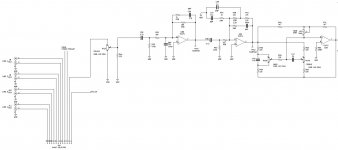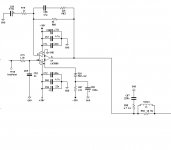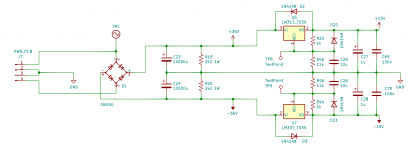Hi guys,
I'm currently working on a project that involves the LM3886 as power stage.
A pre amplifier based on TL07x, a tone stack with same opamp and final the powerful LM3886. For reference the schematic is reported in attachment.
First of all: it works perfectly, the volume control is ok and tone too. 🙂
But I'm facing a major issue: at the output with an oscilloscope I can measure an oscillation (2Vpp) with a frequency of 30~31kHz.
The circuit is implemented into a 2 layer PCB, the ground is well routed using ground planes (power + signal) and a star connection with the power supply.
The power supply is linear with just a bridge rectifier and a couple of electrolytic capacitors.
Taking into account the schematic, is there something that can be causing this oscillation? Maybe some component that requires special care to the surrounding layout.
I'm currently working on a project that involves the LM3886 as power stage.
A pre amplifier based on TL07x, a tone stack with same opamp and final the powerful LM3886. For reference the schematic is reported in attachment.
First of all: it works perfectly, the volume control is ok and tone too. 🙂
But I'm facing a major issue: at the output with an oscilloscope I can measure an oscillation (2Vpp) with a frequency of 30~31kHz.
The circuit is implemented into a 2 layer PCB, the ground is well routed using ground planes (power + signal) and a star connection with the power supply.
The power supply is linear with just a bridge rectifier and a couple of electrolytic capacitors.
Taking into account the schematic, is there something that can be causing this oscillation? Maybe some component that requires special care to the surrounding layout.
Attachments
The inputs of U2B are swapped!
Are the resistances of R80 and R83 swapped?
C31 is marked DNP, is it indeed not placed? I wouldn't be surprised if it caused instability when placed, although not at such a low frequency.
Are the resistances of R80 and R83 swapped?
C31 is marked DNP, is it indeed not placed? I wouldn't be surprised if it caused instability when placed, although not at such a low frequency.
Last edited:
U2B has been patched into the board and two inputs are now swapped. R80 and R83 are correct and not swapped and the components marked as DNP are not placed.
But I can’t understand how this oscillation can be propagated from the last stage to the first, and the measure in TP10 is lower (in terms of Vpp). The oscillation is increasing from the first stage to the last. I don’t remember now the values but tomorrow I can performe another measure session if needed.
The power supply is linear with just a bridge rectifier and a couple of electrolytic capacitors.
Please show the full power supply arrangement. In particular the low voltage rails and decoupling.
A picture of the board would be useful too.
Sid.
I would expect R83 to be << R80, as otherwise the lead compensation through C55 doesn't work. Mind you, I haven't read the datasheet, this is just a general remark about lead compensation (a.k.a. a phantom zero) in the feedback network.
D2, D3, D20 and D21 are either unnecessary or much too small, but that's not what causes your oscillations.
If C27 and C28 are normal aluminium electrolytic capacitors, then their values have to be increased to at least 22 uF. Having the wrong type or value of capacitor there can cause oscillations, and those can occur at a relatively low frequency - I have wondered since the start of this thread why the oscillation frequency isn't hundreds of kilohertz or higher.
If C27 and C28 are normal aluminium electrolytic capacitors, then their values have to be increased to at least 22 uF. Having the wrong type or value of capacitor there can cause oscillations, and those can occur at a relatively low frequency - I have wondered since the start of this thread why the oscillation frequency isn't hundreds of kilohertz or higher.
That's great!
Getting back to D2, D3, D20 and D21, I think you have to change them to 1N4002 if you want to be absolutely sure that switching off the amplifier while it is playing at maximum volume into low-impedance loudspeakers will never blow up the regulators or the diodes.
You also may have to look at the minimum load current of the regulators. They are guaranteed to work from 10 mA onwards and their feedback networks only draw 1.25 mA, so the op-amps have to draw at least 8.75 mA to meet the minimum load spec.
Getting back to D2, D3, D20 and D21, I think you have to change them to 1N4002 if you want to be absolutely sure that switching off the amplifier while it is playing at maximum volume into low-impedance loudspeakers will never blow up the regulators or the diodes.
You also may have to look at the minimum load current of the regulators. They are guaranteed to work from 10 mA onwards and their feedback networks only draw 1.25 mA, so the op-amps have to draw at least 8.75 mA to meet the minimum load spec.
- Home
- Amplifiers
- Solid State
- LM3886 with oscillation @ 30kHz


